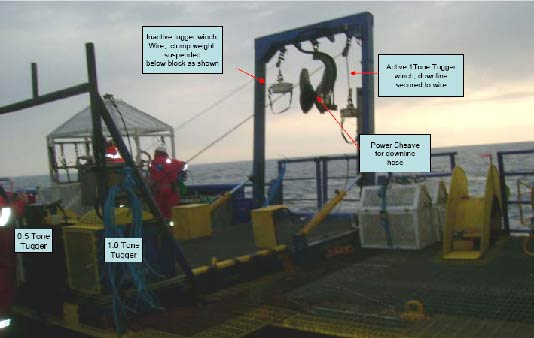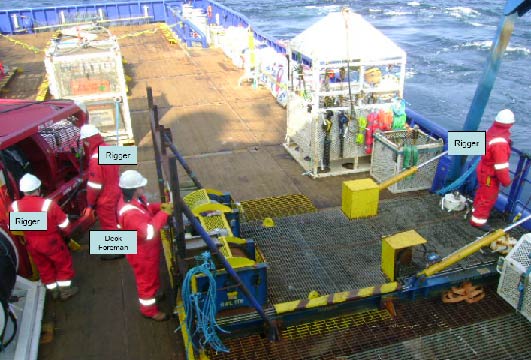- Discover how we are helping Members reduce emissions: Explore the ProjectGHG hub now.
- Join the global DP Community at the IMCA DP Conference in Amsterdam. 21 and 22 May. Book now
- Register your interest for the IMCA Global Summit 2024. 3-4 December, Utrecht, Netherlands.
- Now booking. Underwater Ship Husbandry Seminar. 10 October 2024, Singapore.
Near-miss: Dropped clump weight
A member has reported an incident in which a clump weight was inadvertently dropped to the seabed. The incident occurred during diving operations when operating a deck mounted tool deployment A-frame which incorporated two tugger winch systems and a downline powered sheave. Each tugger winch wire had an 88kg clump weight attached. One tugger was operational, deployed subsea with a downline secured to the wire at 10m intervals and the other inactive with the clump weight suspended just below the snatch block.
While recovering the tugger wire with downline to the surface, it was noticed that the winch wire clump weight could potentially foul the guard rails on the A-frame. The decision was made to boom out the A-frame further. As the A-frame was boomed out, the clump weight on the inactive wire rode up into the snatch block (because the tugger winch was not paid out as the boom was extended). The winch wire parted and the clump weight dropped to the seabed.
The clump weight landed on a protection structure approximately 10m from the divers who were working in an adjacent manifold. No one was injured and no equipment was damaged but there was a high potential for serious injury to the divers and for damage to subsea assets.


Following investigation it was discovered that the following factors contributed to the high potential near miss:
- The supervisor in charge of the operation on deck was himself operating the winch and A-frame rather than supervising ‘hands off’;
- The task risk assessment in place for the operation was not complete and did not cover all aspects of hazard and risk;
- There was no limit switch or proximity device fitted to safeguard against collision;
- The second tugger clump weight assembly was too close to the A-frame snatch block (when it should have been stowed with sufficient slack to take up any extension);
- There was a lack of awareness regarding the position of the second tugger winch clump weight and of the potential consequences of letting out the boom on the A-frame.
The following corrective/preventative actions were taken:
- Review of operating procedures and risk assessments for the use of lifting appliances incorporating independent hydraulic ram and winch controls, including:
- awareness of hook/load position when operating A-frame
- position of divers – exclusion zone for divers to be determined from dropped object analysis and this should be written into operating procedures and risk assessments
- warning notices to be posted on A-frames
- deck crew to be familiarised and deemed competent to operate equipment;
- Supervisors should be remain ‘hands off’ and in a position to monitor and control operations;
- Operations requiring the over-boarding of anything when divers are in the water should require a dedicated toolbox talk to discuss and review over-boarding task risk assessment;
- Full communication and agreement between the deck supervisor controlling the deck over boarding operation and the dive supervisor regarding:
- the imminent over-boarding of a load
- that divers are clear of the dropped object exclusion zone.
Safety Event
Published: 19 June 2009
Download: IMCA SF 08/09
IMCA Safety Flashes
Submit a Report
IMCA Safety Flashes summarise key safety matters and incidents, allowing lessons to be more easily learnt for the benefit of all. The effectiveness of the IMCA Safety Flash system depends on Members sharing information and so avoiding repeat incidents. Please consider adding [email protected] to your internal distribution list for safety alerts or manually submitting information on incidents you consider may be relevant. All information is anonymised or sanitised, as appropriate.
IMCA’s store terms and conditions (https://www.imca-int.com/legal-notices/terms/) apply to all downloads from IMCA’s website, including this document.
IMCA makes every effort to ensure the accuracy and reliability of the data contained in the documents it publishes, but IMCA shall not be liable for any guidance and/or recommendation and/or statement herein contained. The information contained in this document does not fulfil or replace any individual’s or Member's legal, regulatory or other duties or obligations in respect of their operations. Individuals and Members remain solely responsible for the safe, lawful and proper conduct of their operations.
